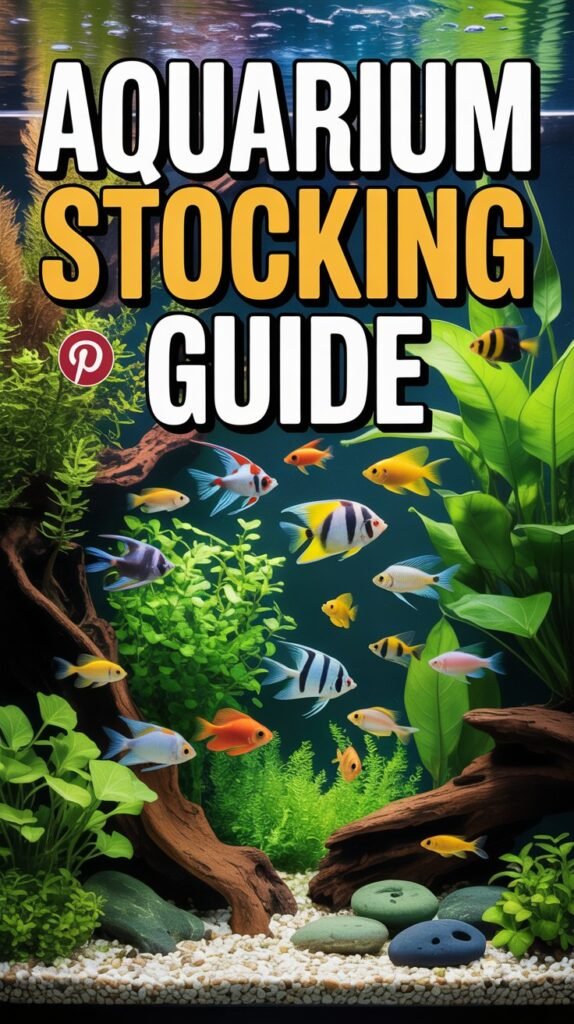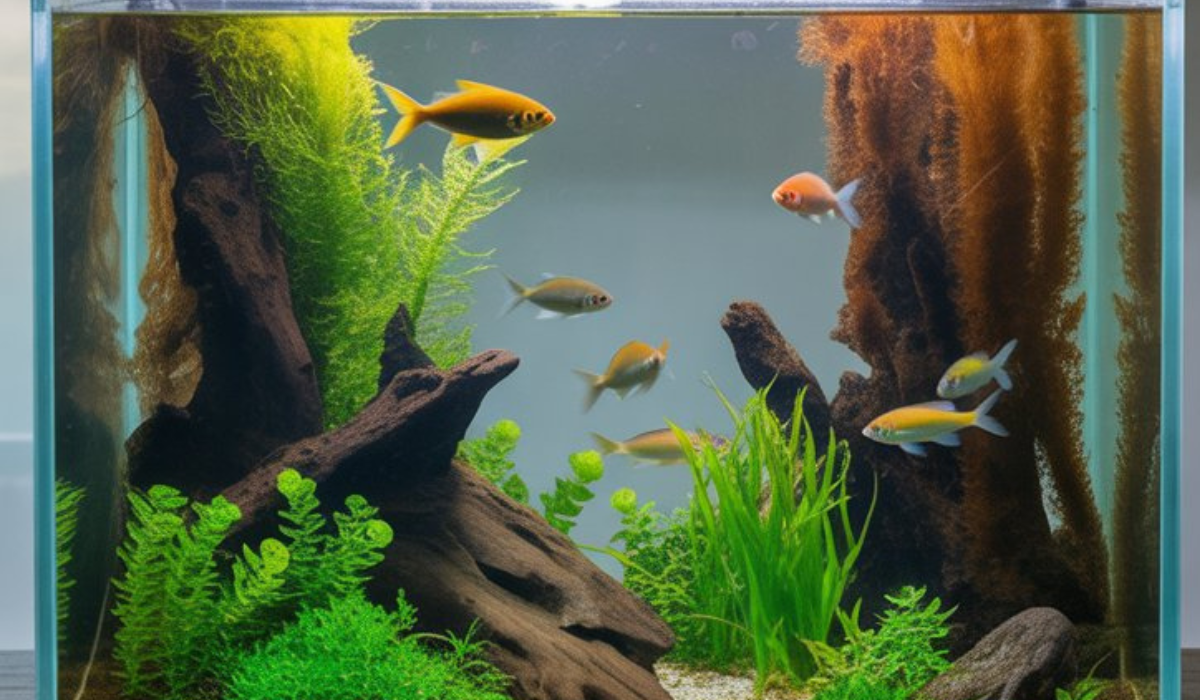Setting up an aquarium is an exciting journey that blends creativity, science, and responsibility. One of the most crucial aspects of aquarium keeping is stocking — the process of choosing and adding the right combination of fish and other aquatic species to your tank. A well-stocked aquarium isn’t just visually stunning; it’s also stable, harmonious, and healthy for its inhabitants.
In this complete Aquarium Stocking Guide, we’ll explore how to determine the right number and types of fish for your tank, avoid common mistakes, and maintain the perfect aquatic balance. Whether you’re setting up a freshwater community tank, a nano aquarium, or a large planted setup, this article will help you plan your aquarium like a professional aquarist.
What Is Aquarium Stocking?
Aquarium stocking refers to deciding how many fish — and which species — to add to your aquarium. It involves considering the fish’s size, temperament, water requirements, and compatibility with other tank mates.
A well-stocked aquarium ensures that:
- Fish have enough space to swim and grow.
- The biological filter can handle the waste load.
- Fish are compatible and don’t stress or harm each other.
- The ecosystem remains balanced and visually appealing.
Improper stocking, on the other hand, can lead to aggression, poor water quality, and even fish deaths.
Understanding the Importance of Proper Stocking

Before adding fish, it’s essential to understand why proper stocking matters.
- Maintains Water Quality:
Overcrowding produces excessive waste, leading to high ammonia, nitrite, and nitrate levels — all toxic to fish. - Prevents Aggression:
Too many fish or incompatible species can cause territorial disputes, stress, and injuries. - Supports Fish Health:
Adequate space reduces stress, boosting fish immunity and lifespan. - Ensures Biological Balance:
A balanced aquarium supports beneficial bacteria that keep the nitrogen cycle stable. - Improves Aesthetic Appeal:
A well-planned stock of colorful, peaceful fish creates a beautiful, natural-looking display.
Factors to Consider Before Stocking an Aquarium
1. Tank Size and Shape
The size of your aquarium determines how many and what kind of fish you can keep.
- Small tanks (5–20 gallons): Best for nano species like guppies, tetras, or shrimp.
- Medium tanks (30–55 gallons): Suitable for community setups with fish like angelfish, mollies, or corydoras.
- Large tanks (75+ gallons): Can accommodate larger or semi-aggressive species such as cichlids or gouramis.
The shape also matters — longer tanks provide more horizontal swimming space, which most fish prefer over vertical depth.
2. The “One Inch per Gallon” Rule — and Its Limitations
A common guideline for beginners is the “1 inch of fish per gallon of water” rule. While helpful, it’s only a rough estimate.
For example:
- 10 gallons = 10 inches of total fish length.
However, this rule doesn’t account for:
- Fish body mass (some are bulkier than others).
- Swimming habits (active swimmers need more space).
- Filtration efficiency and water parameters.
It’s better to research each species’ adult size and space requirements rather than relying solely on this rule.
3. Fish Compatibility
Not all fish get along. Some species are territorial, while others are schooling and peaceful. Before adding fish, check compatibility based on:
- Temperament: Peaceful, semi-aggressive, or aggressive.
- Water preferences: pH, temperature, hardness.
- Diet: Carnivorous, herbivorous, or omnivorous.
For example:
- Guppies, tetras, and mollies coexist peacefully.
- Betta fish may attack others with long fins.
- Cichlids often require species-specific setups.
4. Filtration and Oxygenation
A powerful filtration system is essential for handling waste. If your filter can process more water per hour (measured in GPH — gallons per hour), you can safely stock slightly more fish.
Proper oxygenation is equally vital. Overcrowded tanks deplete oxygen quickly, stressing fish and beneficial bacteria.
5. Fish Behavior and Swimming Zones
Fish occupy different areas of the tank:
- Top dwellers: Guppies, hatchetfish, bettas.
- Mid-level swimmers: Tetras, rasboras, gouramis.
- Bottom dwellers: Corydoras, loaches, plecos.
Combining species from different zones creates a dynamic and balanced tank without overcrowding one area.
6. Growth Potential
Always consider a fish’s adult size — not its size at purchase. Many species grow significantly larger over time, and overcrowding can happen gradually if you’re unaware of this.
7. Maintenance Routine
If you can perform weekly water changes and maintain stable water parameters, your tank can support a higher bio-load. If maintenance is irregular, keep fewer fish.
Step-by-Step Aquarium Stocking Process

Step 1: Cycle the Aquarium
Never add fish to an uncycled tank. Cycling allows beneficial bacteria to establish and process fish waste safely.
A properly cycled tank converts:
- Ammonia → Nitrite → Nitrate.
This process usually takes 4–6 weeks.
Step 2: Plan Your Fish List
Research and make a list of species you like. Then check:
- Compatibility with each other.
- Water parameter requirements.
- Full-grown size and diet.
Aim for a mix that balances aesthetics, behavior, and environmental needs.
Step 3: Introduce Fish Gradually
Add only a few fish at a time — usually 2–3 small fish per week. This allows your filter and bacteria to adjust to the increased bio-load.
Monitor ammonia and nitrite levels after each addition.
Step 4: Quarantine New Fish
Always quarantine new fish in a separate tank for 2–3 weeks before adding them to your main aquarium. This prevents diseases and parasites from spreading.
Step 5: Observe and Adjust
Watch how the fish behave once added. Signs of aggression, stress, or illness indicate an imbalance. Adjust your stocking or tank layout if necessary.
Ideal Aquarium Stocking Examples
Here are examples of balanced setups based on tank size and theme:
10-Gallon Nano Aquarium
- 6 Neon Tetras
- 3 Corydoras Pygmaeus
- 1 Mystery Snail or 2 Shrimp
Peaceful, colorful, and easy to maintain.
20-Gallon Community Aquarium
- 6 Guppies
- 5 Harlequin Rasboras
- 4 Corydoras Catfish
- 1 Honey Gourami
This setup offers vibrant colors and activity at all tank levels.
40-Gallon Freshwater Planted Tank
- 8 Zebra Danios
- 6 Cherry Barbs
- 6 Otocinclus Catfish
- 1 Bristlenose Pleco
- 2 Dwarf Gouramis
This mix ensures a healthy ecosystem and algae control.
75-Gallon Semi-Aggressive Aquarium
- 4 Angelfish
- 8 Giant Danios
- 6 Rainbowfish
- 3 Clown Loaches
Provides balance between territorial and active fish with plenty of space.
Common Aquarium Stocking Mistakes
1. Overstocking
Too many fish overwhelm the tank’s biological capacity, leading to ammonia spikes, oxygen depletion, and disease outbreaks.
2. Ignoring Fish Growth
Buying small juvenile fish without considering their adult size results in overcrowding later.
3. Mixing Aggressive and Peaceful Species
Combining incompatible fish causes stress and injury. Research temperament before stocking.
4. Skipping Quarantine
Introducing unquarantined fish risks spreading infections like ich or fin rot to the entire tank.
5. Poor Filtration
A weak or clogged filter can’t process waste efficiently, harming your aquarium’s health.
6. Adding All Fish at Once
Rapid stocking disrupts the nitrogen cycle. Always add fish gradually.
Balancing the Aquarium Ecosystem
To maintain a thriving ecosystem:
- Monitor water parameters: Keep ammonia and nitrite at 0 ppm, nitrates below 20 ppm.
- Feed appropriately: Small, regular feedings reduce waste.
- Perform regular water changes: Replace 25–30% weekly.
- Add live plants: They absorb excess nutrients and oxygenate the tank.
- Include algae eaters: Snails, shrimp, or plecos help with natural cleaning.
A balanced tank requires consistency and observation more than frequent interventions.
Stocking Freshwater vs. Saltwater Aquariums

Freshwater Tanks
- Easier for beginners.
- Fish are more adaptable to small fluctuations in water parameters.
- Examples: Guppies, tetras, barbs, corydoras.
Saltwater Tanks
- Require more precise monitoring of salinity and pH.
- Stock fewer fish per gallon due to higher bio-load.
- Examples: Clownfish, gobies, tangs, wrasses.
While saltwater tanks can be visually stunning, freshwater aquariums are more forgiving and easier to manage for new hobbyists.
Tips for Successful Aquarium Stocking
- Research Each Species Thoroughly.
Know your fish’s adult size, temperament, and water needs. - Avoid Impulse Purchases.
Don’t buy fish just because they look attractive in the store. - Use Reliable Test Kits.
Monitor ammonia, nitrite, nitrate, and pH regularly. - Choose Active and Healthy Fish.
Avoid fish with damaged fins, clamped tails, or dull colors. - Provide Hiding Spots.
Decor, caves, and plants reduce stress by giving fish territory and security. - Balance Gender Ratios.
For livebearers like guppies, keep a ratio of 1 male to 2–3 females to avoid stress. - Be Patient.
Stocking an aquarium is a gradual process that can take weeks or months.
Long-Term Stocking Management
Once your aquarium is fully stocked, you’ll need to manage population growth and maintain harmony:
- Control Breeding: Many livebearers reproduce rapidly. Consider separating sexes or introducing natural predators.
- Rehome or Trade Fish: If a species outgrows your tank, find it a suitable new home.
- Observe Behavior: Any signs of aggression or lethargy should be addressed immediately.
- Maintain Equipment: Clean filters, check heaters, and ensure stable water conditions.
A sustainable stocking plan keeps your aquarium beautiful and stress-free for years.
Conclusion
A well-stocked aquarium is not just about adding colorful fish — it’s about creating a balanced, thriving ecosystem. The key is to plan carefully, research thoroughly, and proceed slowly. By considering factors such as tank size, fish compatibility, filtration, and long-term care, you can build an aquarium that is both visually stunning and biologically stable.
Whether you’re keeping a small community tank or a large aquascape, following this Aquarium Stocking Guide ensures your fish stay healthy, your water stays clear, and your aquatic world flourishes naturally.
Frequently Asked Questions (FAQs)
1. How do I know if my aquarium is overstocked?
Signs of overstocking include cloudy water, fish gasping at the surface, high ammonia levels, and increased aggression.
2. How many fish can I put in a 20-gallon tank?
It depends on species and size, but generally, you can keep around 10–12 small fish like tetras or guppies.
3. Can I mix tropical and cold-water fish?
No, they have different temperature requirements. Always match species based on similar water conditions.
4. How often should I test water when stocking?
Test ammonia, nitrite, and nitrate levels weekly — especially after adding new fish.
5. When can I add more fish to my tank?
Wait at least 1–2 weeks between additions to allow your bio-filter to adjust.
6. Do I need to quarantine new fish?
Yes, quarantine for at least 2–3 weeks to prevent introducing diseases.
7. Can plants affect stocking levels?
Yes, live plants help absorb waste and improve oxygenation, allowing slightly higher stocking densities.
8. What happens if I overfeed my fish?
Overfeeding causes waste buildup, poor water quality, and algae growth. Feed only what fish consume in 2–3 minutes.
9. Are algae eaters necessary in every tank?
They’re not mandatory, but they help control algae and keep the tank cleaner.
10. How do I maintain balance after full stocking?
Perform weekly maintenance, avoid overfeeding, and monitor fish behavior regularly.
Final Tip:
Successful aquarium stocking combines knowledge, patience, and observation. Take your time, research your species, and remember — a healthy, balanced aquarium is a result of thoughtful planning and consistent care.

